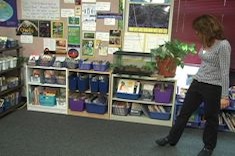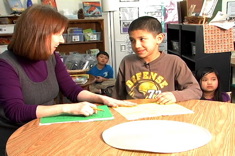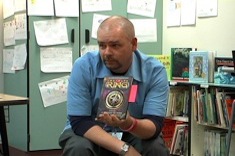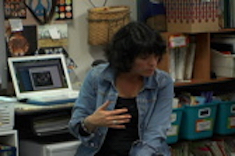4th Grade
Latest Videos
Nonfiction Displays
In this five-minute video room tour, 4th grade teacher Andrea Smith from Dublin, Ohio shows how she builds a classroom community and much of her literacy curriculum from the care and study of unusual pets.
Fourth-Grade Small Group: Writing Paragraphs
In this seven-minute video, Aimee Buckner uses a mentor text to demonstrate how writers construct lively nonfiction paragraphs. The small group has been pulled together because the students need more practice in adding details to their writing.
Writing a Strong Ending
Tony Keefer confers with Tommy about writing a strong ending for his piece.
Girls Book Share Group
Franki Sibberson shares a range of books that include compelling female characters with a group of fourth-grade girls.
Stuck on a Thesis
In this conference with a 4th grader, Beth Lawson works with a student who has chosen a challenging essay topic and is struggling to develop his thesis.
Book Talks in 4th Grade
Tony Keefer previews Infinity Ring with his fourth graders, and talks about the value of book talks for building a reading community.
Science Challenge
Franki Sibberson’s students share results from the science challenge homework. The class discussion is a collaborative reflective process.
Using Wonderopolis in Classrooms
Franki Sibberson uses the website Wonderopolis with her fourth-grade students. By modeling how to navigate the site, she encourages her students to use the web in more thoughtful ways.
The Lunch Lady and Gender in Reading
Franki Sibberson’s students discuss an opinion/argumentative article that suggests boy readers should also read books with female protagonists.
Owl Research: Marking Up Text
Andrea Smith explains a close reading activity her fourth-grade students will complete as part of an owl research project.
The Sponge Summary Lesson: Understanding Summaries
Heather Rader teaches a fourth-grade class, using the analogy of a sponge to explain how summaries work. In this video, the students review the four rules used for nonfiction summaries and corresponding kinesthetic movements and brainstorm a list of “what’s important to know about summaries.”
The Sponge Summary Lesson: Introduction
Heather Rader teaches a fourth-grade class, using the analogy of a sponge to explain how summaries work. In this video, the students review the four rules used for nonfiction summaries and corresponding kinesthetic movements and brainstorm a list of “what’s important to know about summaries.”
Using Comics in Literacy Workshops
Franki Sibberson works with her 3rd and 4th graders to use comics in the literacy workshop. Students study a variety of comics and list common attributes in small- and whole-group settings.
Running and Reading Logs
Clare Landrigan and Tammy Mulligan have ideas to assess and refresh logs in the classroom. In this video excerpt, Clare uses the analogy of how runners use logs to chart progress and set goals and encourages the students to come up with a log that will help them as readers.
Nonfiction Word Hunt
Word study and nonfiction reading are combined in Franki Sibberson's whole-group nonfiction word hunt activity. Each child shares which word he or she found, where it was found, and reflects on what the discoveries mean to the community of word learners.
“If You Like Matt Christopher” Student Book Share
In this video, two boys share other books beyond the writing of Matt Christopher that might interest their three classmates. The boys report on the books and describe components that are important to them.
Science Workshop Whole Class Debrief
In this final video in a three-part series, Jennifer Morgan discusses what was learned during a science observation and writing activity in her grades 3 and 4 classroom. She charts and inquires while students share out what they learned.
Word Choice Lesson: A Collaborative Coaching Session
Jennifer Allen collaborates with a new teacher, Jessica, early in the fall to teach a lesson in Jessica’s 4th grade classroom. Click here to download the workshop guide. COMMON CORE...
Science Writing: Small Groups
In this second video in a three-part series, Jennifer Morgan leads her grades 3 and 4 students as they work together in small groups on a science and writing task. She focuses on her role as a listener and gives the opportunity for the students to express how they are organizing their observations and data collection.
Science Writing Workshop Part 1
Jennifer Morgan leads her third-and fourth-grade students through the process of observing, talking, and writing in their science journals as they perform an experiment. In Part 1, she presents the task to students and connects it with previous learning.
Main Ideas, Summaries, and Notes in a Reading Conference
In this conference with a 4th grader, Aimee Buckner tackles text choice, notes, and main ideas all in less than five minutes.
Grade Level
Browse Videos By
Instructor
- Melissa Quimby
- Nawal Qarooni
- Gwen Blumberg
- Julie Cox
- The Lead Learners
- Hannah Tills
- Josie Stewart
- Ruth Metcalfe
- Mallory Messenger
- Becca Burk
- Jodie Bailey
- Vivian Chen
- Mary Brower
- Tiffany Abbott Fuller
- Stephanie Affinito
- Ruth Ayres
- Leigh Anne Eck
- Heather Fisher
- Shari Frost
- Julie Johnson
- Suzy Kaback
- Gigi McAllister
- Shirl McPhillips
- Melanie Meehan
- Cathy Mere
- Debbie Miller
- Tara Barnett and Kate Mills
- Tammy Mulligan
- Dana Murphy
- Bitsy Parks
- David Pittman
- Brenda Power
- Heather Rader
- Matt Renwick
- Mandy Robek
- Christy Rush-Levine
- Gretchen Schroeder
- Jen Schwanke
- Brian Sepe
- Katherine Sokolowski
- Stella Villalba
- Jennifer Vincent
Choice Literacy Membership
Articles
Get full access to all Choice Literacy article content
Videos
Get full access to all Choice Literacy video content
Courses
Access Choice Literacy course curriculum and training






















